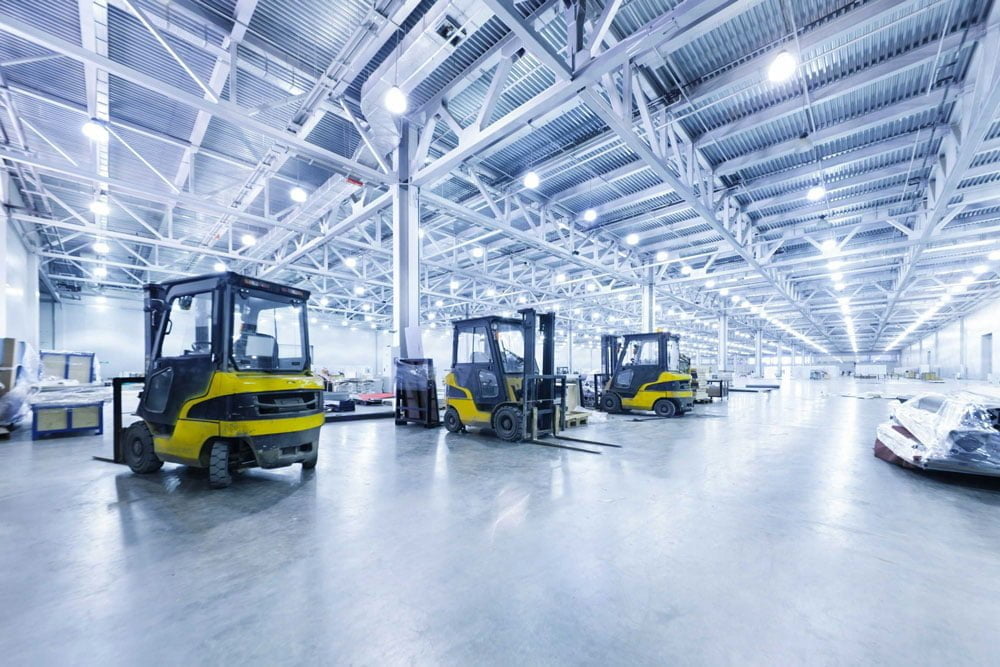
Discover how to reduce costs in industry!
Reducing costs in industry is one of the main challenges of business management, without compromising the quality of products and customer service. This issue has been addressed since the beginning of the Industrial Revolution and has a strong influence on how businesses are currently conducted. LED lighting technology can be an ally when thinking of new solutions.
Meeting the growing demand and keeping costs low are some of the goals of managers who want to increase their return on investment. Therefore, it is important to adopt strategic measures to continue serving the consumer market with quality.
Cutting costs is a decision that requires a thorough analysis so that choices are not based on insufficient or inaccurate information. Industrial companies of any segment and size can improve their processes to make operations more economical and thus obtain a significant increase in profitability.
In this post, we will present details on tips for reducing costs and workplace accidents, improving inventory control, and much more! Keep reading!
Map the cost structure
To identify opportunities for cost reduction, it is necessary to know where the company’s financial resources are going. This is a way to give visibility to the volume of expenses and provide the manager with the ability to evaluate financial results.
In general, this information is available in an integrated management system, such as SAP, which records all transactions, from the purchase of raw materials to the sale of finished products. The reports obtained are important when formulating the annual budget and for setting goals related to each area’s expenses.
Fixed costs are not related to the structure to maintain the company and are apportioned among the products in the composition of the selling price. Direct costs, on the other hand, are linked to the production of each type of product present in the catalog. Inputs and resources may vary, so their calculation is linked individually.
It is important to note that taxes related to the acquisition of supplies also integrate this type of cost. Regarding indirect costs, know that identifying and calculating this type of costing presents greater complexity because it is not possible to link them to a specific product. Packaging is an example of this category but must be accurately determined.
Seek to increase productivity
One of the principles of management establishes that fixed production costs are diluted according to the volume produced. This means that investing in methods to increase production represents an opportunity to minimize costs. Some examples of effective tools are:
Robotics technology; Integrated management systems; Employee training; Modern machinery with higher energy efficiency; Organizing physical space to reduce travel time.
Use these alternatives to increase profitability and keep teams motivated. Technologies have a positive impact on results, no matter what your field of operation is. But believe me, for production to increase, several factors must be observed in a factory.
Avoid production process downtime
It is natural for machinery, equipment, and tools to wear out over their useful life. However, the manager must be aware of avoiding machines breaking down and interrupting production. Production variability is also a factor to be avoided, as process slowdowns result in a decline in operational efficiency.
The solution that can be adopted is to monitor the functioning of machines, especially electric motors, which are responsible for driving their operation and depend on the consumption of electrical energy. Periodic inspections and maintenance scheduling are necessary if parts need replacing. This proactive attitude contributes to avoiding larger problems.
Invest in LED lighting alternatives
Many industrial companies keep their operation running 24 hours a day, in a shift system. It is important to focus on energy consumption and tariffs, as this is an essential input for carrying out any activity. Therefore, it is advisable for the manager to analyze their expenses and seek savings in the production line.
There are several alternatives that function to significantly increase energy efficiency. Among them is the use of LED luminaires, which were created with the intention of illuminating large spaces, such as industrial sheds.
It is estimated that direct savings can exceed 70% of consumption and generate a return on investment within a short period, especially if LED reflectors are used in combination.
However, to ensure that the installation is carried out safely and respecting the infrastructure of the location, it is necessary to have partnerships with specialized companies that develop a complete project and offer support. Specialized professionals perform a lighting calculation and make a personalized and ideal plan for each case.
Seek process automation
We have already mentioned how robots can increase productivity on the production line. However, industrial automation can take on various forms and act in different departments.
In warehouses, for example, it is possible to implement conveyors to move materials quickly, which allows for safer handling. Even the administrative area can have improved processes with the use of robots that work together with management systems.
In this way, repetitive tasks can be automated, avoiding the incidence of human error. Consequently, employees are free to perform other more relevant activities.
Encourage team training
Continuous professional improvement is one of the keywords for reducing costs in industry. Both operational and administrative teams can benefit from the implementation of internal courses and training. In this way, materials are formulated according to the company’s needs and to achieve the following objectives:
Maintain focus on customer demands; Enable increased efficiency; Expand opportunities for innovation; Demonstrate problem-solving ability; Ensure increased proactivity and productivity.
A professional who is updated on the main technologies and work methodologies presents significant improvements in their performance. They realize that the company is investing in their training and feel more secure to be part of the business’s evolution. With this, engagement increases and results improve significantly.
Adopt control methodologies
The economy obtained is the result of a constant exercise that must be reinforced to integrate the organizational culture. Therefore, it is important to establish short, medium and long-term goals to evaluate the progress of the results obtained.
This means that the details should be exposed clearly and rationally so that their acceptance by the team is more comprehensive and lasting. Cost cutting is a very common expression in the corporate world.
After all, if excess spending is identified, it is advantageous to seek solutions to eliminate it. Frequently, however, the actions applied are inefficient. Reducing the quality of inputs, for example, is a risky measure that can generate a decrease in sales volume due to customer dissatisfaction.
This aspect highlights that it is essential to reflect on how to reduce costs in the industry so that the operation is not harmed. Implement the use of control and monitoring methodologies to follow the organization’s internal processes. Thus, employees will be more committed to the future of the business.
Ensure safety at work
Safety at work is essential for reducing unnecessary expenses. An accident can interrupt production, cause panic among employees, and hinder the completion of essential tasks. When an employee is injured, they end up being removed from the company for recovery.
Consequently, the industry needs to carry out a new selection process and find someone qualified to make the temporary replacement. Not to mention the expenses that may arise with the filing of lawsuits to collect indemnities. A labor lawsuit generates payment of the conviction, judicial costs, and attorney’s fees.
Therefore, have reliable production lines and adopt all measures to avoid machine and equipment failures. Invest in a lighting project planned by specialist professionals and avoid insufficient lighting causing problems for your industry.
Improve internal communication
Employees should be informed about the decision to reduce costs and made aware of the measures that need to be taken to achieve the objectives. The strategies adopted to eliminate expenses and improve management need to involve the collaborators who are part of the process.
They can contribute with new ideas, since they are in daily contact with the places and equipment. Hold meetings and encourage teams to participate and present improvement suggestions.
Ask for help to define goals, and when employees are able to achieve them, prepare a prize for the teams. Offer training, periodic updates, training in new technologies, and courses on time management and teamwork.
Spread good practices
Conscious consumption practices are essential for the adoption of sustainable attitudes that minimize environmental impact. Look for innovative measures that strengthen the brand image and so that the industry is recognized as eco-efficient. The culture of zero waste is just one example of the methods that companies already adopt.
Use educational stickers that deal with saving electricity and water in bathrooms and kitchens. Do not buy disposable cups for employees and prefer glass cups. Allow the use of the printer only to print what is really necessary and encourage paper saving.
Work with suppliers in your region to minimize costs with displacement and transportation, and foster income generation in the vicinity. Talk to a specialist about the possibility of generating your own energy, since electricity bills tend to be high in Brazil. Keep the lights off in rooms where there are no activities, in addition to adopting new energy sources.
Solar panels are a great option to ensure long-term savings. You can also replace traditional roofs with materials that facilitate the entry of light into the environment, but check if it is worth making the investment before implementing it. Some systems can be expensive and require preparation before being implemented.
Adopt an SOP
Standardization of processes is facilitated by the SOP (Standard Operating Procedure). It is a document that translates the planning of the work to be executed in a certain period, containing all the fundamental aspects.
It produces improvements in several areas, including maintenance. The lack of standardization generates failures, since professionals will not have a guide to work.
The POP addresses the procedures to be taken in case of equipment breakdown, the records of services performed, the responsible parties for the activities, the stages of preventive maintenance to be performed on each machine, and the manager responsible for the document. Large organizations use the method to apply to sectors where there is a shift change, for example.
Invest in JIT methodologies
The JIT (Just-In-Time) methodology influences the reduction of costs and the increase of profitability in businesses. Implement JIT concepts to optimize processes and not have to spend more resources than you really need in your production. Refill your industry with what it needs at the right time to increase productivity.
With the adoption of this method, your production system will generate the exact amount of products needed to meet actual customer demand. It dispenses with the use of sales projections and prevents stocks from becoming overloaded. In reality, in JIT, there is no need to have inventory, since the raw material is purchased in the exact amount and according to the industry’s needs.
Improve inventory control
Materials that are stagnant in inventory generate losses in revenue and storage costs, and goods can end up being lost. Working capital and cost reduction can be improved if inventory is efficient.
Purchase raw materials only after receiving an order from your customer so that they have a specific destination and there is no production waste.
These are the 13 tips on how to reduce costs in the industry! Don’t forget that industrial lighting projects are already impacting the market through the adoption of technological innovations and systems that are essential for eliminating expenses. Efficiently manage resources and promote sustainable business development to maintain ecosystem balance!
Now that you’re convinced that SX Lighting will provide you with the best lighting with energy savings, click here and request assistance from our specialists.
Share







